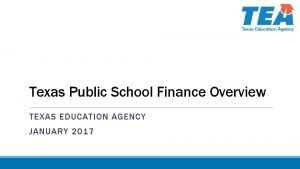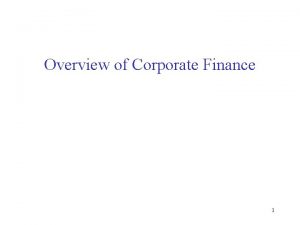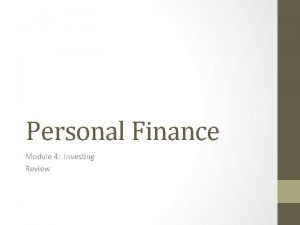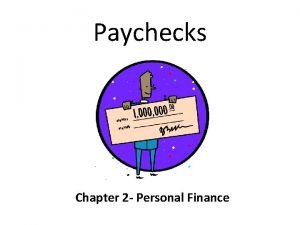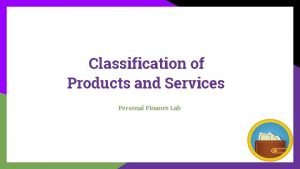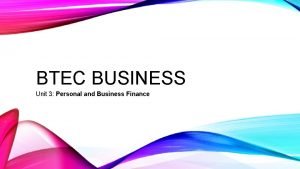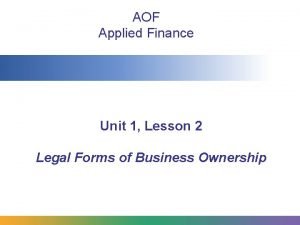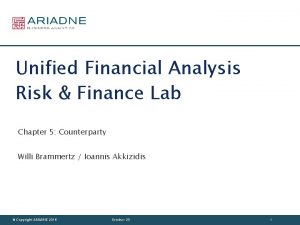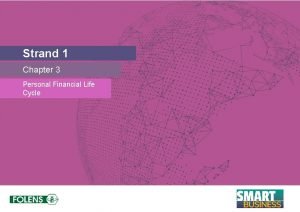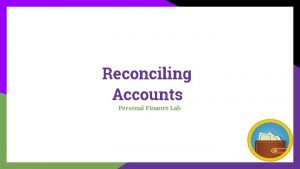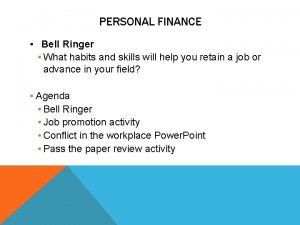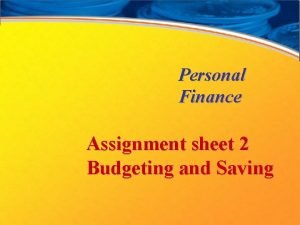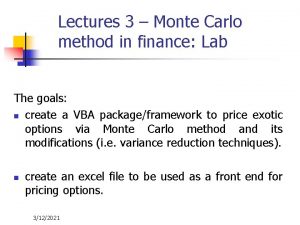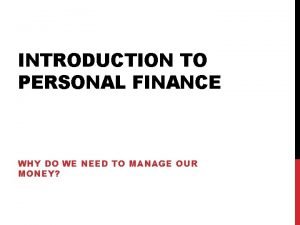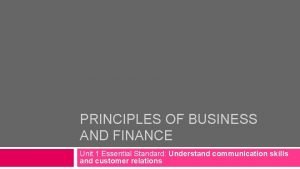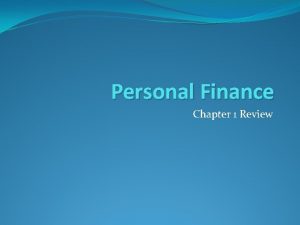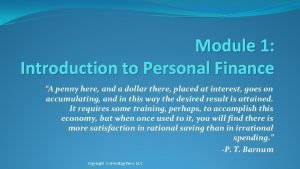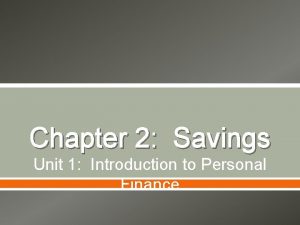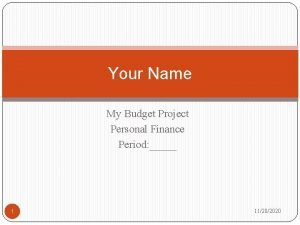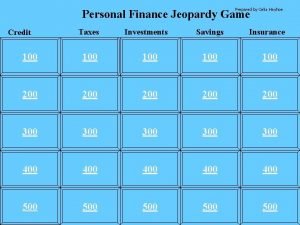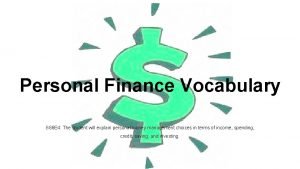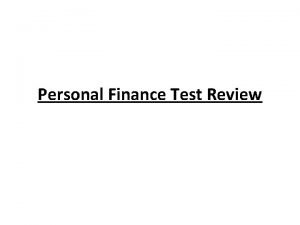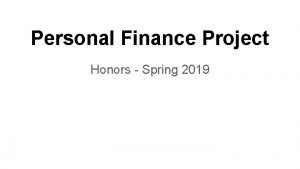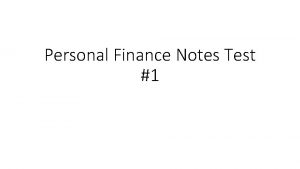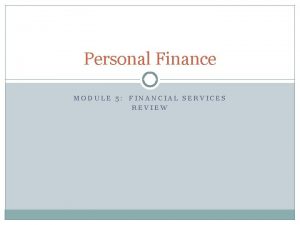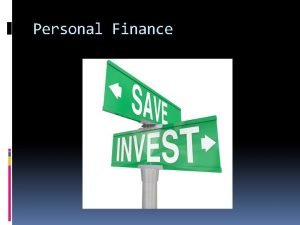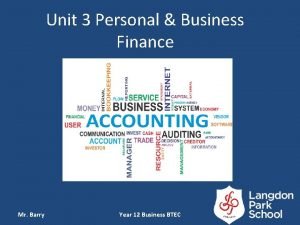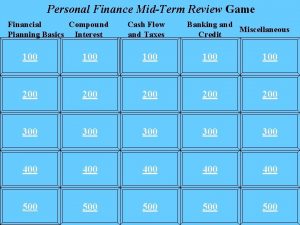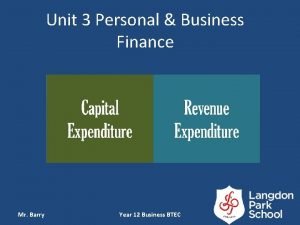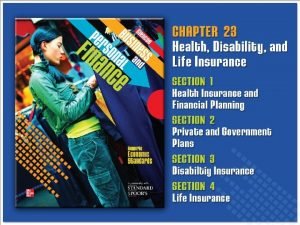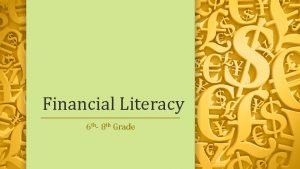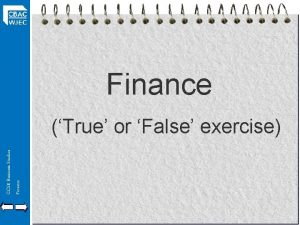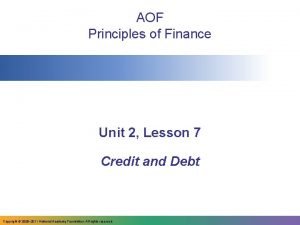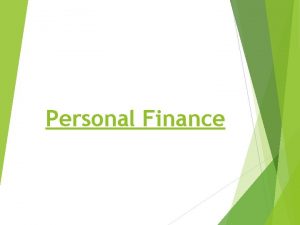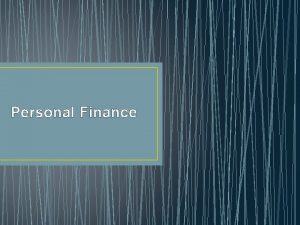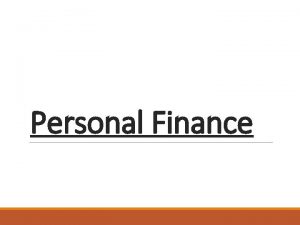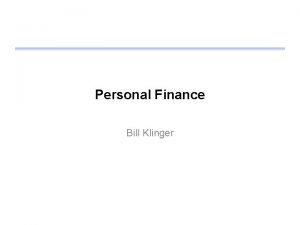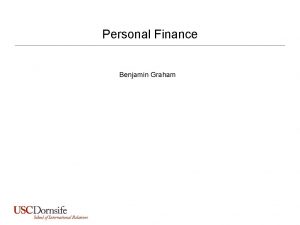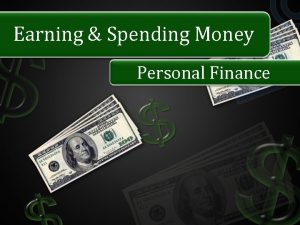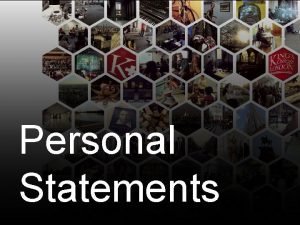GoodheartWillcox Co Inc 6 Personal Finance An Overview































































- Slides: 63

© Goodheart-Willcox Co. , Inc.

6 Personal Finance: An Overview

Objectives • Prepare a budget tailored to income and needs. • Prepare cash flow and net worth statements. • Plan family finances for different stages in the life cycle. • Give examples of economic, demographic, cultural, and technological factors that can impact financial planning. continued

Objectives • Explain ways to deal with a financial crisis. • Identify important financial and legal documents to keep on hand.

Preparing Financial Statements • Financial planning enables you to – reach important goals – achieve a sense of financial security for life • Financial security is the ability to meet essential needs without taking on more debt than you can repay continued

Preparing Financial Statements • Financial literacy is – having a basic understanding of knowledge and skills needed to manage financial resources – being aware of and knowledgeable about financial management options – feeling secure in your ability to make your resources work for you continued

Preparing Financial Statements • Financial statements include – budget – cash flow statement – net worth statement

Tailoring a Budget to Income and Needs • A budget helps you manage – income and spending – day-to-day expenses • Creating a basic budget involves seven steps

1. Establish Financial Goals • List your financial goals • Your goals will change over time

2. Estimate and Total Your Income • Determine a budget period • Estimate income from each source • Total the estimated income

3. Estimate and Total Your Expenses • Fixed expenses – must be paid each budget period – are often the same or nearly the same amount from month to month – include payments for rent, mortgage, tuition, insurance premiums, and auto and other loans continued

3. Estimate and Total Your Expenses • Variable expenses – can change from month to month, both in amount and time to pay – can often be pared down or cut – include payments for food, clothing, medical expenses, discretionary expenses continued

3. Estimate and Total Your Expenses • Use a form to estimate and total expenses

Building Savings into Your Budget • Build savings into a budget for – unexpected emergencies: medical expense, car repair, a possible period of unemployment – medium- and long-term goals – investments to improve your financial circumstances

Charitable Giving as an Expense • Budget for philanthropy by giving to reputable charities • Making donations may lower taxes

4. Analyze Current Income and Spending • Subtract expenses from income • If the number is positive, you have money left over for goals • If the number is 0 or negative, find ways to increase income or cut expenses continued

4. Analyze Current Income and Spending • Ways to increase income: – Handle more responsibilities at home to possibly increase your allowance – Get a part-time job – If you work, negotiate a raise or increased hours continued

4. Analyze Current Income and Spending • Ways to reduce spending: – Reduce or cut discretionary expenses – Reduce fixed and variable expenses – Cut expenses unrelated to goals and priorities

5. Prepare a Trial Budget • Use goals, income, and expenses • Use estimated expenses

6. Put Your Budget into Action • Fill in actual amounts for income and expenses • If actual amounts exceed budgeted amounts, identify the cause • Revise budget using actual costs • Study budget before making financial decisions

7. Evaluate Your Budget Periodically • Is your budget working? • Are you reaching important goals and setting new ones? • Are you controlling your spending? • Has your income or spending pattern changed? • Do life changes call for adjustments?

Preparing a Cash Flow Statement • Shows real income and spending • Inflow is income; outflow is expenses • Prepare at end of budget period continued

Preparing a Cash Flow Statement • By recording income and expenses, you get a good picture of your spending patterns

Preparing a Net Worth Statement • Net worth = assets – liabilities – Positive net worth lets you meet your financial obligations and goals, and accumulate wealth – Negative net worth can be eliminated by reducing expenses or increasing income continued

Preparing a Net Worth Statement • This measures your financial standing at a specific point in time

Assets • Liquid assets are easily converted to cash – Cash, money in savings • Investment assets are invested funds set aside for long-term goals – Stocks, bonds • Use assets are durable goods – Auto, furniture

Liabilities • Current liabilities are items that must be paid soon, usually within a year – Medical bill, taxes, credit card bill • Long-term liabilities are obligations paid over a longer period of time – Mortgage, student loan

Planning Family Finances • Factors affecting adult budgeting decisions are – age – stage in the family life cycle • Families can skip, overlap, or repeat family life cycle stages continued

Planning Family Finances • Family life cycle stages – Beginning – Expanding – Developing – Launching – Aging

Beginning Stage • Move away from parents, obtain higher education, marry, start jobs and careers • Expenses: education, college loans, home down payment, auto, home furnishings, insurance

Expanding Stage • Job advancement, increasing income, increasing responsibilities, childbirth, and parenting • Expenses: child-related costs, increased insurance protection, increased housing expenses

Developing Stage • Parenting school-age children and adolescents, climbing income and expenses • Expenses: child- and school-related costs, second car, retirement planning

Launching Stage • Departure of children from home, peaking earnings, aging parents • Expenses: college, retirement savings, costs of caring for aging parents

In Your Opinion • Which stages of the family life cycle can you recognize in your own family’s history? Were any stages skipped or repeated?

Aging Stage • Retirement, earnings drop, “empty nest”, birth of grandchildren, caring for elderly parents, estate planning • Expenses: medical costs, insurance, travel, costs of caring for elderly parents • Security at this stage depends on earlier planning

Variations in the Cycle • Singles and childless couples skip the expanding, developing, and launching stages • Single parents who remarry may repeat stages with new spouses continued

Variations in the Cycle continued

Variations in the Cycle • Single-parent female-headed families often have less income, less savings • After separation and divorce, income often falls while expenses increase

Financial Decisions in a Changing World • Other forces impacting financial decisions: – Economic factors – Social factors – Cultural factors – Technology factors • Financial planning and saving help people cope with economic challenges

The Economy and Your Finances • During good economic times, – consumers and business owners are optimistic – most people who want jobs can find them – income and savings rise – people save and invest for the future continued

The Economy and Your Finances • During a recession, – people are pessimistic – people fear or experience job loss – incomes stagnate – people spend less; save more continued

The Economy and Your Finances • During inflation, – prices rise faster than income – money buys less – people cannot buy or save as much

Demographics and Your Finances • Demographic trends that impact the economy and people’s finances – An aging population – Changing job market – Rising educational requirements for jobs – More young adults living with their parents

Culture and Your Finances • Greater ethnic, cultural, religious diversity, especially in urban areas • More relationships and marriages between people of different backgrounds • Cultural and ethnic traditions can affect financial decisions

Technology and Your Finances • New technology can have financial impacts • Example: medical advances led to longer lives and the need for more savings continued

Technology and Your Finances • Positive impacts of advanced technology: – New markets in which to buy and sell – Wider variety of goods and services – Less expensive goods and services – New jobs – New money management tools – Easy access to information continued

Technology and Your Finances • Problems created by advanced technology: – Offshore outsourcing—businesses move factories and jobs to other countries to benefit from cheap labor and weaker government regulations – American workers competing for jobs with lower-paid workers may lose jobs, benefits, or take pay cuts

Working Through Financial Problems • To minimize a financial crisis, – get the best education and job training possible – keep debt under control – create emergency fund; save regularly – avoid taking excess risks – get insurance protection – discuss finances with household members

Unexpected Crisis • Some crises cannot be anticipated or prepared for in advance continued

Unexpected Crisis • Causes of a family crisis include – job loss – separation and divorce – death – disability – serious illness – natural disaster continued

Unexpected Crisis • To cope with a family crisis – discuss problem with adult members of household – list your resources – minimize negative financial consequences – get the help of professionals

Keeping Important Documents • Keep documents and papers necessary for financial and legal transactions • Develop a recordkeeping system

Key Lists to Keep Current and Available • Savings and checking accounts • Credit card and charge accounts • PINs (personal identification numbers) • Securities and investment records • Wills and trusts • Insurance policies • Loan contracts, including mortgage continued

Key Lists to Keep Current and Available • Tax records • Property deeds and titles • Pension plans and employee benefits documents • Social Security and Medicare records • Property, possessions, and valuables • Product information and warranties • Instructions for management of your affairs

Scheduling Bills • Set aside a specific place to put bills as they arrive • If you don’t receive an expected bill, contact the business right away • Keep track of due dates • Set a special time for bill paying • Pay bills in the order they are due

Keeping Budgeting Records • Your files should contain records related to income, spending, and savings • Keep receipts for – fixed expenses – purchases you may want to return – purchases that may need warranty service

Central Ideas of the Chapter • Enjoying financial security throughout life is an achievable goal. • Budgets and other financial planning tools can help people achieve financial security.

Glossary of Key Terms • budget. A spending plan for the use of money over time based on goals and expected income. • cash flow statement. A summary of the amount of money received as well as the amount paid out for goods and services during a specific period. Back

Glossary of Key Terms Back • demographics. The statistical characteristics of the population. • expense. The cost of a good or service a person buys. • family crisis. A major problem that impacts the future of the family and its lifestyle.

Glossary of Key Terms Back • family life cycle. The stages of change a family passes through from formation to aging. • financial literacy. The understanding of the basic knowledge and skills needed to manage financial resources. • fixed expense. A set cost that must be paid each budged period.

Glossary of Key Terms Back • income. Any form of money a person receives from various sources. • liability. A financial obligation that a person currently owes or will owe in the future. • net worth. The difference between what a person owns and owes.

Glossary of Key Terms • net worth statement. A written record of a person’s current financial situation. • philanthropy. The act of giving money, goods, or services for the good of others. • recordkeeping. The process of setting up and maintaining an organized system for your financial affairs. Back

Glossary of Key Terms Back • variable expense. A cost that changes both in the amount and time it must be paid. • wealth. An abundance of assets that are accumulated over time.
 Overview of personal finance chapter 1
Overview of personal finance chapter 1 Foundation in personal finance chapter 1 answers
Foundation in personal finance chapter 1 answers Texas recapture districts
Texas recapture districts Texas public school finance overview
Texas public school finance overview Corporate finance overview
Corporate finance overview Corporate finance overview
Corporate finance overview Apple outline
Apple outline The basic rule of a risk-to-return relationship is that …
The basic rule of a risk-to-return relationship is that … Chapter 2 personal finance
Chapter 2 personal finance Personal finance gcse
Personal finance gcse Unsought products
Unsought products Btec business unit 3 grade boundaries
Btec business unit 3 grade boundaries Personal finance lab
Personal finance lab Llc advantages and disadvantages
Llc advantages and disadvantages Personal finance lab
Personal finance lab Life cycle personal financial planning
Life cycle personal financial planning Personal finance lab
Personal finance lab Chapter 8 personal finance
Chapter 8 personal finance Personal finance bell ringers
Personal finance bell ringers Personal finance assignment
Personal finance assignment Personal finance lab
Personal finance lab Introduction to personal finance
Introduction to personal finance Chapter 8 personal finance
Chapter 8 personal finance Principles of business and finance
Principles of business and finance Personal finance unit 1 review
Personal finance unit 1 review Chapter 4 review personal finance
Chapter 4 review personal finance Chapter 1 post test personal finance
Chapter 1 post test personal finance Personal finance module
Personal finance module Glencoe personal finance
Glencoe personal finance Five foundations of personal finance definition
Five foundations of personal finance definition Personal finance basics and the time value of money
Personal finance basics and the time value of money Personal finance budget project
Personal finance budget project Personal finance jeopardy
Personal finance jeopardy Personal finance vocabulary
Personal finance vocabulary Personal finance test
Personal finance test Personal finance project
Personal finance project Personal finance notes
Personal finance notes Module 5 financial services
Module 5 financial services Principles of personal finance
Principles of personal finance Personal finance final exam review
Personal finance final exam review Chapter 11 finances and career planning
Chapter 11 finances and career planning Personal business finance
Personal business finance Solar sqa
Solar sqa True or false personal finance questions
True or false personal finance questions Personal finance midterm
Personal finance midterm Investinwhatsnext
Investinwhatsnext Unit 3 personal and business finance
Unit 3 personal and business finance Ja personal finance
Ja personal finance Glencoe business and personal finance
Glencoe business and personal finance Financial literacy grade 8
Financial literacy grade 8 Personal finance gcse
Personal finance gcse Geographic trends definition personal finance
Geographic trends definition personal finance Unit 2 lesson 12 interest rates
Unit 2 lesson 12 interest rates Verbos en infinitivo, gerundio y participio
Verbos en infinitivo, gerundio y participio Adivinanzas sobre la higiene personal
Adivinanzas sobre la higiene personal Personal na misyon
Personal na misyon Www overview
Www overview Maximo work order priority
Maximo work order priority Uml overview
Uml overview Uml overview
Uml overview Vertical retail
Vertical retail Figure 12-1 provides an overview of the lymphatic vessels
Figure 12-1 provides an overview of the lymphatic vessels Systemic circulation flow chart
Systemic circulation flow chart Walmart
Walmart



